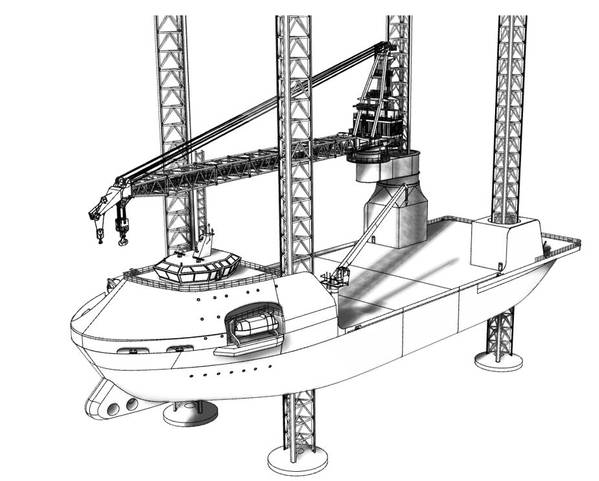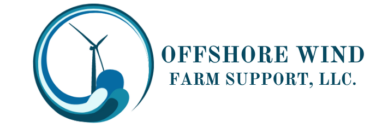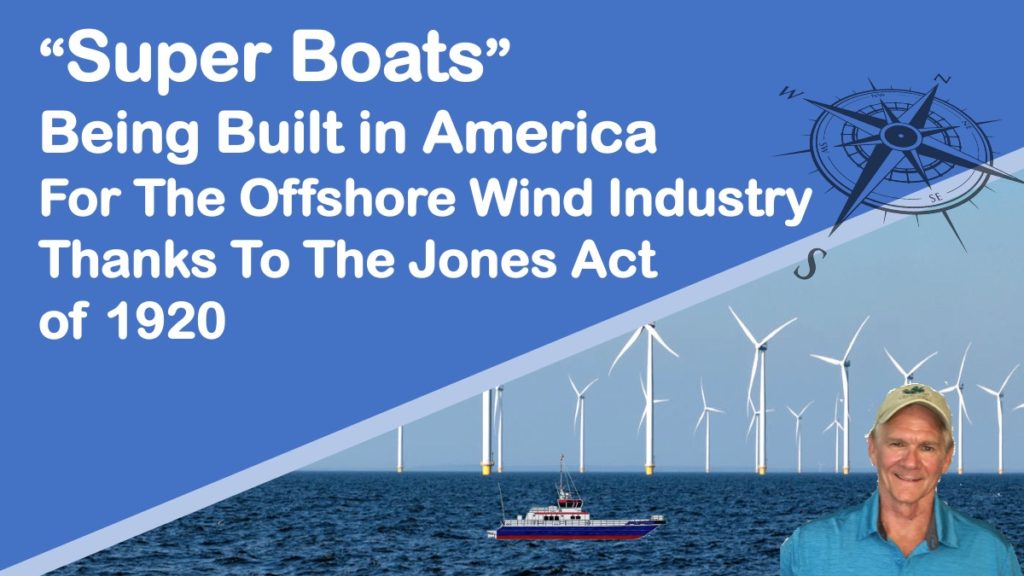THANK YOU JONES ACT!
American boat builders should be very busy over the next few years building all sorts of boats for the Offshore Wind Industry. Thanks to the Jones Act of 1920.
The Jones Act was created in 1920 to protect U.S. shipping interests.
It bars foreign-flagged ships from shipping merchandise between points in the United States and protects American shipyards and boat builders.
This means in simple terms, vessels must be built in the United States, owned by U.S. citizens, U.S. flagged and and crewed by U.S. seafarers in order to provide transportation of merchandise by water, or by land and water, between points in the United States.
Click The Link Below To Read Jones Act
https://en.wikipedia.org/wiki/Merchant_Marine_Act_of_1920
And thanks to that, American boat builders should be very busy over the next few years building all sorts of boats for the Offshore Wind Industry.
Right in the nick of time too because the Offshore Oil industry is in terrible shape and boat builders are struggling to keep the doors open.
Before we go any further, let me tell you a quick story:
As I write this article I am literally working as a Liaison on a foreign flagged vessel. We have been on a project over the past 3 weeks and the crew and I have built up a nice rapport.
They are just as interested in the “American” as I am in them. We share meals together obviously share stories about our families, our lives, and of course, country leadership and politics.
Without mentioning particulars, I can tell you with utmost honesty the deckhands and general labor onboard the vessel is paid about the same as American labor performing the same work, but that is where the similarity ends.
From AB’s, Q-meds, Engineers, Mates, DPO’s and Master of the vessel, the pay is 25% – 30% of what American pay is.
So as not to confuse, the pay is 70% – 75% LESS.
There is no way in the world an American Mariner could live on wages that low. If it weren’t for the Jones Act, there would not be an American mariner or boat builders in existence.
THANK YOU Wesley Livsey Jones for
Introducing The Jones Act !
Below is an article about a couple new boats being built in the USA that are Jones Act Compliant.
There is going to be a need for about thousand boats shortly and thanks to the Jones Act, they will be built in American Yards by American Employees.
I find it interesting that by America lagging behind the rest of the world in the Offshore Wind Development process, the European Countries blazed the trail and figured this stuff out so we can now we can come in behind them and build bigger, better and more efficient vessels to increase efficiency, decrease costs and maybe even take over the market.
The article is quite interesting.
2nd Wind Marine Reveals Design for U.S. Offshore

Louisiana-based company 2nd Wind Marine plans to design, finance, build and operate two Jones-Act-compliant jack-up vessels aimed at the growing U.S. offshore wind market.
The company has this week revealed the SuperFeeder design for the vessel planned to be used for transporting next-generation offshore wind turbines from the US marshaling ports out to awaiting wind turbine installation vessels.
“The MiNO Marine SuperFeeder design being built in coordination with 2nd Wind Marine is a modern, Subchapter I compliant vessel 124.5 m in length and 40m wide (overall) with a 5m hull depth. Current plans are for the simultaneous construction of two vessels,” 2nd Wind Marine said in a statement.
The company said that a pair of these Jones Act-compliant vessels, designed by naval architecture firm MiNO Marine, would offer the quickest, and a proven, path to US offshore wind development.
The Jones Act, passed in 1920 to protect U.S. shipping interests, bars foreign-flagged ships from shipping merchandise between points in the United States. Under the coastwise laws, only a vessel that is built in the United States, owned by U.S. citizens, documented under U.S. registry, and crewed by U.S. seafarers may “provide any part of the transportation of merchandise by water, or by land and water, between points in the United States to which the coastwise laws apply.”
2nd Wind Marine said its two new vessels will each be capable of transporting one complete set next-generation wind turbine components from US ports to offshore windfarm sites enabling optimized construction throughput and the most efficient utilization of non-Jones Act compliant wind turbine installation vessels.
The fully DP-2 vessels will each be propelled by three 2,500kW Z-Drives and two 1,200kW tunnel bow-thrusters with the intent to maintain 10 knots while laden.
The vessels are to be primarily diesel-electric with medium speed Tier-IV engines. The house is offset asymmetrically to the port side to allow more bow deck space to accommodate tomorrow’s larger vertically stacked blade racks and will also be able to accommodate a total of 60 persons (20 crew & 40 offshore workers) in single and double berthed MLC-2006 compliant staterooms.
The cargo deck rated to transport, and jack up with, 4,000 MT has a double deck so changes in grillage can be easily facilitated without concern to vital tank and void space below and is intended to be able to carry a complete next-generation turbine set (tower, nacelle, & blades), 2nd Wind Marine said.
The vessels will be outfitted with a Liebherr designed crane installed around a jacking leg with an offset-pedestal allowing access to more than 95% of the vessel’s cargo deck space.
Per 2nd Wind Marine, the crane will be capable of lifting each component of next-generation wind turbines from quayside to the vessel’s cargo deck. Further, an extended boom variant will allow for blade change-outs in the wind turbine field.
“The MiNO Marine designed hull form was developed through extensive engineering analysis using computational fluid dynamics (CFD) methods to yield an efficient hull form suitable for a wide range of offshore operating conditions while also minimizing potential for flow induced drag. U.S. shipyards have been engaged and are currently evaluating the design and preparing construction cost and timeline estimates,” 2nd Wind Marine said.
“At Offshore Wind Farm Support, we’ll continue to monitor for opportunities to assist OffShore Wind Farming with public relations, community outreach and education, digital marketing, and more.
if we can help you in any way, please feel free to contact us at (877) 207-8652

